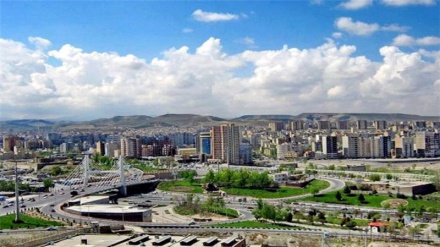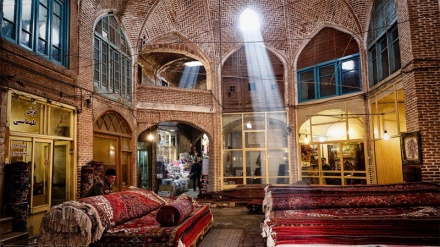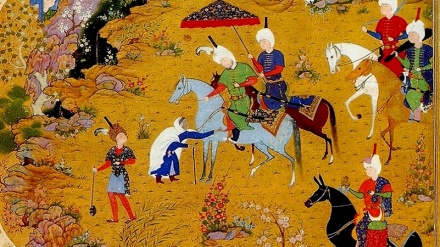Tabriz, 2018 (5)
Welcome to this week's episode of the series Tabriz, 2018. This city has been the tourism capital of the Islamic countries and a means for establishment and maintenance of a cultural bond among neighboring countries, throughout the course of history. As of ancient times, this city has been a global tourism attraction site. Tourists, who have traveled to this city, have admired and adored it. Today, we review some of their views.
Travelogues detail the observations of enthusiastic tourists in different cities. The readers of travel books; upon reading these books, gain some information about the historical sites, mosques, libraries, marketplaces, geographical position, climate, national and religious traditions and customs, and languages of the locals of tourism destinations. The fact of the matter is that travelogues are comprehensive encyclopedias; upon reference to which one grasps the social, political, and economic realities of people in different phases in time.
One of the reasons that led some to pen travelogues was the absence of easy and comfortable means of transportation. In contrast to the contemporary era, in which different tools have assisted mankind, the absence of means of communication distanced people from each other, such that the diversity of cultures and traditions was shrouded in obscurity.
Study of travelogues enables us to spot developed, cultured, and burgeoning cities, and makes us realize which regions have further influenced human civilization. Iran has caught the attention of innumerable tourists and explorers from different parts of the world, throughout the course of history, who have mentioned Iran's cities and cultural features in their travelogues. Description of Tabriz and its scenic landscapes is no exception to this rule. These travel books certainly help us in gaining an understanding of this city's ancient history. At this point, we pay a glance at some of these travelogues, and the descriptions which they have rendered on the city of Tabriz.
Nasser Khosrow is a famed Iranian poet, philosopher, and tourist, whose life spanned from 394 AH to 481 AH. He traveled to different regions for seven years and went on the Hajj pilgrimage thrice.
In this travel book, he points out that he arrived in the city of Tabriz in the year 438 AH, adding that Tabriz is a large and well-developed city.
He was told that an earthquake had rocked that city in the year 434 AH. Within the night in which the earthquake struck, the city was completed razed to the ground, leaving more than 40,000 people dead. The governor of that city rebuilt the city of Tabriz in the year 435 AH, turning it into a highly developed city.
As of then, Nasser Khosrow penned the developments and events which took place throughout his journeys. Meanwhile, he was not the only one who was keen to jot down his travelogue. Another famed traveler, Yaqout Hamvi, the prominent geographer and historian of the 7th Century AH went on adventurous journeys at a young age, visiting Kish, Oman, Greater Syria, and other parts of Asia.
He visited the city of Tabriz in the year 1213 AD, detailing this city in his travel book and pointing out: Tabriz is the best known city of Azarbaijan Province. It is a well-developed city with solid walls which are made of bricks and plaster, and rivers and creeks running through this city. The town is surrounded with orchards, and its fruits are cheap. The city's apricots are especially tasty and one of a kind. The buildings in this city are mainly made of red bricks and plaster. Furthermore, a large number of scientists have risen into prominence in this city.
Undoubtedly, you are familiar with the celebrated Venetian traveler, Marco Polo, and have heard of his adventurous trips. He lived in 13th Century AD, registering the details of his journeys in his travel book. Today, this travelogue plays a pivotal and decisive role in identification and familiarization with the civilizations of Asia, Iran, and China.
In the year 1295 AD, throughout his journey to Tabriz, he pinpoints: "Tabriz is a grand city, which is wealthier and prettier of all of the cities I have traveled to. In this region, there are many cities and fortifications. However, Tabriz is the best of them all. The residents of this city make a living out of trade, and preparation of silk and broidered garments. Many of the garments produced in Tabriz are made of satin, and are highly valuable and beautiful.
The geographical position of this city is suitable for trade, to an extent that traders from India, Baghdad, other warm regions, and different parts of Europe head toward this city to sell and purchase different items and products."
In addition to this Venetian traveler, French tourists have also spoken of their journeys to this city. Jean Chardin was the first French traveler, who referred to Iran, the legendary Iranian poet, Ferdowsi, and his collection of poems, Shah Nameh, in his travel book, and although the information he presented in these domains was limited; he managed to capture the attention of art lovers toward Iran's culture and arts.
In the year 1673 AD, he traveled to the city of Tabriz, noting that the city was a trade hub and the largest and most populous city in Iran. He added that: "Tabriz was divided into nine districts, accommodating around 15,000 homes and 15,000 shops, while its marketplaces were more developed than marketplaces in other regions. The crowded markets, and severalty of shops, once again proved the development of this large city. The best section of this city's markets, belongs to jewelry shops. There are 300 guest houses in this city; the smallest of which can accommodate 300 passengers. This city is full of silk industries and goldsmiths; and the best Iranian products area made in Tabriz.
The means of livelihood are abundant in this city and products are cost-effective in Tabriz. In the meantime, more than 60 different types of grapes are cultivated throughout orchards in this city."
One of the unique features of this city is its mild and moderate climate and its scenic landscapes. The German researcher and geographer, Adam Olearius, who lived in 17th Century AD, authored two books in regards to his observations in his visit to Iran. He traveled to Iran via Russia and the Caspian Sea and has detailed the city of Tabriz in his travel book. He points out the mild and moderate climate of this city, while adding 'it is said that patients are remedied in this city without consumption of medications.'
Many types of grape are cultivated in Iran, but the tastiest of these grapes belong to the cities of Tabriz and Shiraz. Tabriz was also the permanent place of residence of Iranian kings and one of the most populous cities of ancient Iran.
MR/SS


